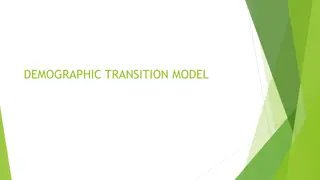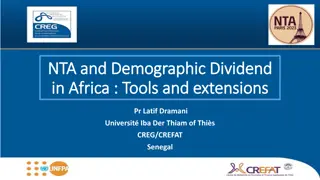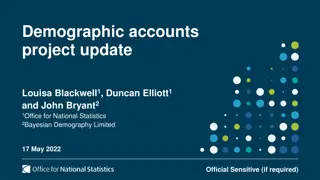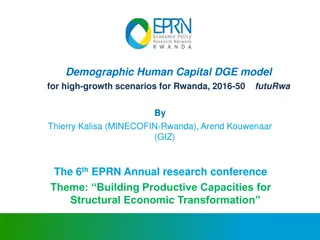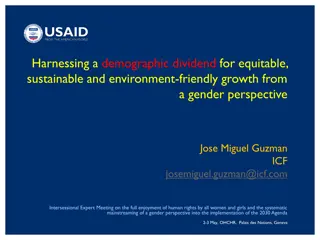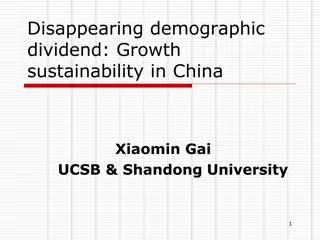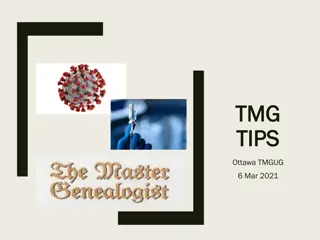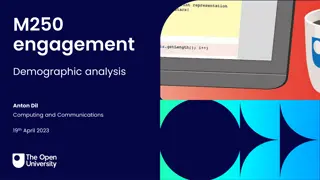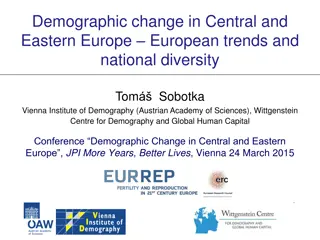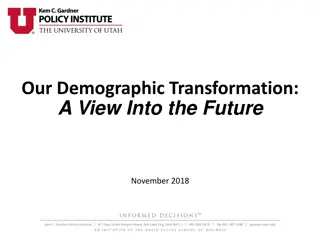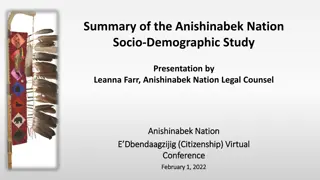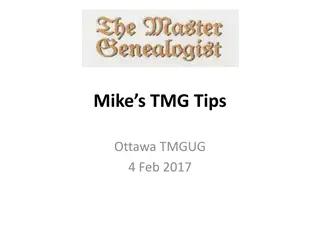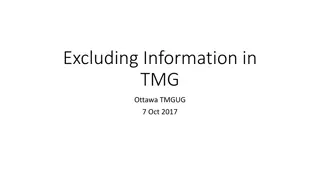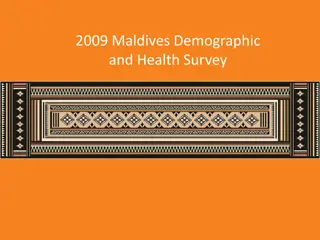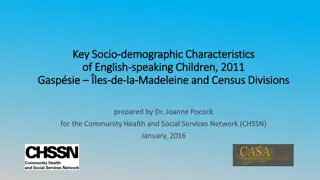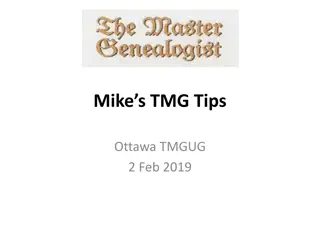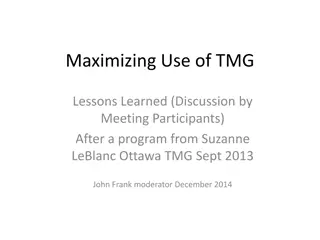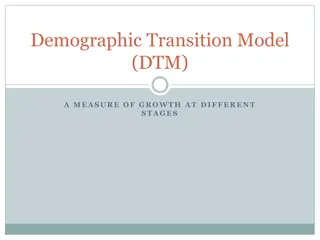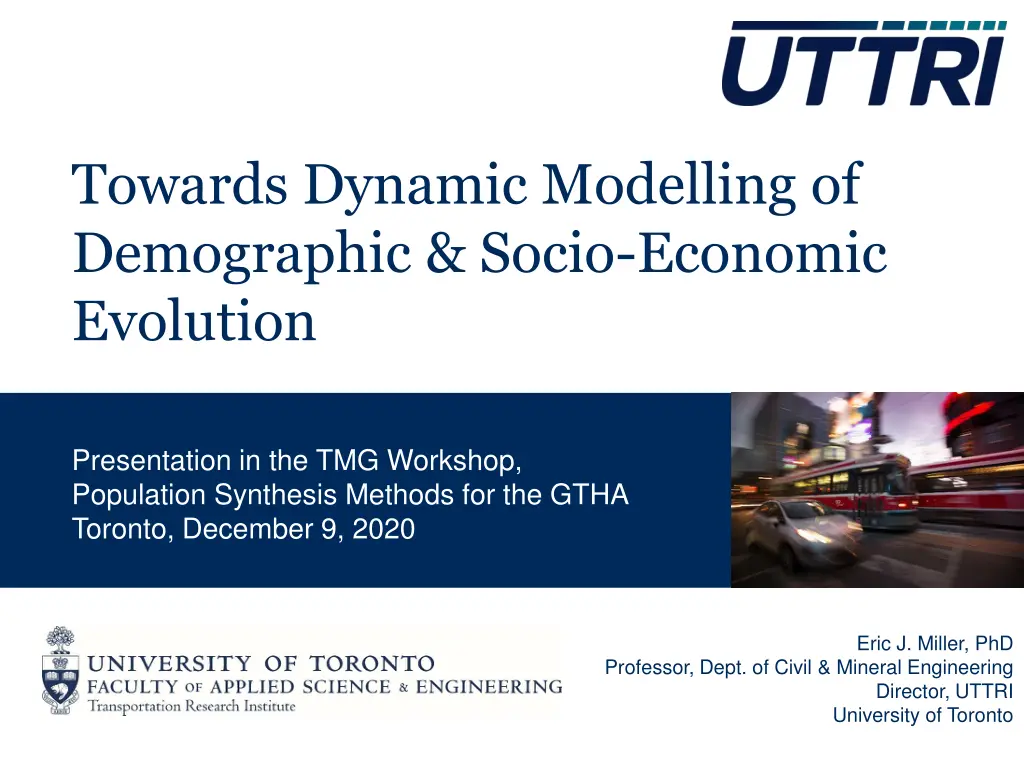
Dynamic Modelling of Demographic & Socio-Economic Evolution in TMG Workshop
Explore dynamic modelling of demographic and socio-economic evolution presented by Eric J. Miller at the TMG Workshop, focusing on the transition from static to dynamic forecasting methods and the impact on population synthesis in the GTHA Toronto area. Learn about the problem definitions, exogenous population and employment forecasts, dynamic vs. static forecasting, and the evolution of the modelling system over time.
Download Presentation

Please find below an Image/Link to download the presentation.
The content on the website is provided AS IS for your information and personal use only. It may not be sold, licensed, or shared on other websites without obtaining consent from the author. If you encounter any issues during the download, it is possible that the publisher has removed the file from their server.
You are allowed to download the files provided on this website for personal or commercial use, subject to the condition that they are used lawfully. All files are the property of their respective owners.
The content on the website is provided AS IS for your information and personal use only. It may not be sold, licensed, or shared on other websites without obtaining consent from the author.
E N D
Presentation Transcript
Towards Dynamic Modelling of Demographic & Socio-Economic Evolution Presentation in the TMG Workshop, Population Synthesis Methods for the GTHA Toronto, December 9, 2020 Eric J. Miller, PhD Professor, Dept. of Civil & Mineral Engineering Director, UTTRI University of Toronto
Presentation Outline Problem definition. Static vs. dynamic forecasting. An evolutionary demographic forecasting model. This presentation is based on: Miller, E.J. (2020) Modelling Demographic & Socio-Economic Evolution: Issues, Options & Propositions for Model Improvement, a Discussion Paper prepared for Metrolinx, August. https://tmg.utoronto.ca/files/Reports/Modelling-Demographic-Evolution_EJMiller_August-2020.pdf
Problem Definition (1) Exogenous Population & Employment Forecasts by Zone At a very high level of abstraction, both GGHM & GTAModel can be represented as consisting of 3 meta components . Agent Synthesis Daily Activity/Travel Demand Road & Transit Network Assignments Model System Outputs: Travel times, costs, volumes, congestion levels, etc. by road link & transit line segment O-D travel times, volumes, etc. by mode & purpose Impacts: pollution, GHG emissions, etc. .
Problem Definition (2) Exogenous Population & Employment Forecasts by Zone Person & Household Synthesis Job & Labour Market Synthesis Job Synthesis: Synthesize jobs by category Population Synthesis: Demographic attributes Socio-economic attributes Labour force participation Create households Assign persons to households PoRPoW Linkages PoRPoS Linkages Mobility Tool Synthesis* Agent synthesis can be decomposed as illustrated. Driver s Licenses Household Auto Ownership And/or car-sharing membership** * GTAModel V4.1 does not synthesize transit pass ownership. ** Car-sharing membership is not modelled in GTAModel V4.1.
Static Forecasting Forecast Year Scenario Assumptions X Base Year, t0 Observed Pop/Emp Forecast Year, tf Synthesized Pop/Emp Forecast year synthesized population & employment directly generated based on assumptions concerning forecast year rates, parameters, etc. No evolution of the system over time. No path dependency. No influence initial, base conditions. Strong static, equilibrium assumptions. Although equilibrium conditions are not usually explicitly enforced.
Dynamic Forecasting Year t1 Assumptions Year t2 Assumptions Base Year, t0 Observed Pop/Emp Year t1 Year t2 . Synthesized Pop/Emp Synthesized Pop/Emp Population & employment evolves in incremental (annual) steps. Path dependent: ??? ? + ? = ??? ? + ??? ? Consistent with / dependent on the initial state. Can co-evolve ELF & EMP. Travel demand can be consistently generated at intermediate years (if desired), not just the forecast end year. Do not need to assume equilibrium at any point in time. Can generate multiple futures, if desired. Important step towards integrated urban models.
Demographic Updating A demographic updating procedure has been developed for the GTHA that updates household, family & person attributes each year in a simulation run. Assumed transition rates by year, categorized by agent attributes are used.
Demographic Updating Closed and discrete time model social networks are maintained Individuals, families and households relationships managed throughout the simulation Processes birth & death, marriage & divorce, in-/out- migration, move-out, driver s license and education different model types as appropriate Data Sources 12 distinct data series from Statistics Canada, the Transportation Tomorrow Surveys, and Ontario registry data from 1986 to 2006
Updating Variables Socioeconomic Events Variables Age Death Out-Migration Birth Driver's License Education Marriage Divorce Age X X X X X X Marital Status X X X X Sex X X X Driver's License Status X Educational Status X Length of Marriage X Driver's License Possession Rate X Out-Migration Rates X Year X X X X X
Person Agent Updates Age Determine whether this person dies this time period (death). If a single adult, determine whether this person out-migrates this time period (out-migration). If a female of child-bearing age, determine whether she gives birth this time period (birth). If 16 years of age or older, determine: Driver s license status Education participation status (education) If single, determine if this person: Marries this time period (marriage). Moves out of the household this time period.
Family Updates Determine if the family will out-migrate this time period. If a husband-wife family, determine if they will divorce this time period (divorce). If in a multi-family household, determine if the family will move out of the household this time period. Update pointers to family members & family type, as required. Family ceases to exist if: A single parent dies. The surviving children are allocated to other families/households. No children remain at home in a single-parent family, either through adult children moving out to form their own households or through death of the children. A husband-wife couple with no children divorces.
Household Updates Update pointers to persons & families, as required. Update household type, as required. Household ceases to exist if no persons are left in it.
Modelling Marriages Marriages can be modelled as a fixed-price (=0) market in which males and females are matched on a utility maximizing basis. The basic algorithm is being applied to other fixed-price markets (labour, rental housing, )
Historical Test Runs, 1986-2006 1986 Census 1986 Initial State Twenty-year simulation runs, 1986-2006 1991 Census 1996 Census 2001 Census 2006 Census Compare run predictions with observed data Other time-series historical datasets (CMHC, TREB, TTS, )
Sample Results Full population run 20 years from 1986 to 2006 ~4 million to ~6 million people ~1.5 million to ~2 million households Parallelized implementation
1986 Age Distribution 70-74 60-64 50-54 40-44 30-34 20-24 10-14 0-4 12% 10% 8% 6% 4% 2% 0% 2% Historical Males Historical Females 4% 6% 8% 10% 12% ILUTE Males ILUTE Females
1996 Age Distribution 70-74 60-64 50-54 40-44 30-34 20-24 10-14 0-4 12% 10% 8% 6% 4% 2% 0% 2% Historical Males Historical Females 4% 6% 8% 10% 12% ILUTE Males ILUTE Females
2006 Age Distribution 70-74 60-64 50-54 40-44 30-34 20-24 10-14 0-4 12% 10% 8% 6% 4% 2% 0% 2% Historical Males Historical Females 4% 6% 8% 10% 12% ILUTE Males ILUTE Females
1986 Females 8.0% 3.0% Divorced (D) and Widowed Married (M) and Single (S) 2.5% 6.0% 2.0% (W) Distribution 4.0% 1.5% Distribution 1.0% 2.0% 0.5% 0.0% 0.0% 20-24 0-4 10-14 15-19 25-29 30-34 35-39 40-44 45-49 50-54 55-59 60-64 65-69 70-74 > 75 5-9 Historical M Historical D ILUTE M ILUTE D Historical S Historical W ILUTE S ILUTE W 1986 Males 10.0% 0.6% Married (M) and Single (S) Divorced (D) and Widowed 0.5% 8.0% 0.4% 6.0% (W) Distribution 0.3% Distribution 4.0% 0.2% 2.0% 0.1% 0.0% 0.0% 25-29 > 75 10-14 15-19 20-24 30-34 35-39 40-44 45-49 50-54 55-59 60-64 65-69 70-74 0-4 5-9 Historical M Historical D ILUTE M ILUTE D Historical S Historical W ILUTE S ILUTE W
2006 Females 10.0% 4.0% Divorced (D) and Widowed Married (M) and Single (S) 8.0% 3.0% 6.0% (W) Distribution 2.0% Distribution 4.0% 1.0% 2.0% 0.0% 0.0% 10-14 15-19 20-24 25-29 30-34 35-39 40-44 45-49 50-54 55-59 60-64 65-69 70-74 > 75 0-4 5-9 Historical M Historical D ILUTE M ILUTE D Historical S Historical W 2006 Males ILUTE S ILUTE W 10.0% 1.0% Married (M) and Single (S) Divorced (D) and Widowed 8.0% 0.8% 6.0% 0.6% (W) Distribution Distribution 4.0% 0.4% 2.0% 0.2% 0.0% 0.0% 25-29 0-4 5-9 > 75 10-14 15-19 20-24 30-34 35-39 40-44 45-49 50-54 55-59 60-64 65-69 70-74 Historical M Historical D ILUTE M ILUTE D Historical S Historical W ILUTE S ILUTE W
ILUTE vs. historical household type distributions Single Fam Indivs Single Indiv Multi Indiv Single Fam Multi Fam 20.8% 2.8% 74.0% 2.2% 0.1% 1986 StatsCan 21.4% 3.7% 71.6% 3.1% 0.2% 1991 22.0% 3.0% 72.5% 2.2% 0.2% 1996 22.2% 2.9% 72.6% 2.1% 0.2% 2001 21.1% 3.3% 74.1% 1.0% 0.5% 1986 ILUTE 23.3% 2.8% 71.9% 1.8% 0.4% 1991 25.3% 2.4% 70.4% 1.7% 0.3% 1996 27.3% 2.2% 68.7% 1.5% 0.3% 2001
Source of Population Changes 0.040 7 Death, Birth and Out-Migration Rates 0.035 6 Population [x 1,000,000] 0.030 5 0.025 4 0.020 3 0.015 2 0.010 1 0.005 0.000 0 1 2 3 4 5 6 7 8 9 10 11 12 13 14 15 16 17 18 19 20 Historical Deaths Historical Births Historical Out-Migration ILUTE Deaths ILUTE Births ILUTE Out-Migration
Percent of ILUTE population with a particular relationship over time 45% 16% Grandparents, GrandChildren 40% 14% Mother, Father and Siblings 35% 12% and Ex-Spouse 30% 10% 25% 8% 20% 6% 15% 4% 10% 2% 5% 0% 0% 1987 1988 1989 1990 1991 1992 1993 1994 1995 1996 1997 1998 1999 2000 2001 2002 2003 2004 2005 2006 Mother Grand Parents Father Grand Children Siblings Ex-Spouse
Social Connections 100% 90% 80% 70% 60% 50% 40% 30% 20% 10% 0% 1986 1991 1996 2001 2006 0 1 2 3 4 5 or More
25 Statistical Tests 1000 replications. Different starting seeds for each replication. 10% sample to speed up run times.
26 Births, Deaths, Marriages and Divorces
27 Spread in Number of Births and Deaths (a) (b) (d) (c)
28 Spread in Number of Marriages and Divorces (b) (a) (c) (d)
Thank you. Let s discuss! 2016 GTHA Employment Levels (2016 TTS)
30 A few references Chingcuanco, F. and E.J. Miller, The ILUTE Demographic Microsimulation Model for the Greater Toronto-Hamilton Area: Current Operational Status and Historical Validation , GeoComputational Analysis and Modeling of Regional Systems , J.C. Thill and S. Dragicevic (eds), Springer, 2018, pp. 139-162. Beykaei, S.A. and E.J. Miller, Testing Uncertainty in ILUTE - An Integrated Land Use-Transportation Microsimulation Model of Demographic Updating , Journal of Civil and Environmental Engineering, 7:1, 2017, 1-9. DOI: 10.4172/2165-784X.1000264. Chingcuanco, F. and E.J. Miller, A Demographic Microsimulation Model for the Integrated Land Use, Transportation, Environment (ILUTE) Model System , pre-print CD 92nd Annual Meeting of the Transportation Research Board, Washington, D.C., January, 2013. Farooq, B., E.J. Miller and F. Chingcuanco, A Dynamic Microsimulation Model for Demographic Updating , presented at the 56th North American Regional Science Association International Conference, San Francisco, November 18-21, 2009. Miller, E.J., F. Chingcuanco, B. Farooq, K.M.N. Habib and M.A. Habib, Development of an Operational Integrated Urban Model System, Volume IV: Demographic & Labour Market, Toronto: Urban Transportation Research & Advancement Centre, University of Toronto, December, 2008, 42 pages. Miller, E.J., Modeling Regional Economics, Land Use, Demographics and Travel: Putting the Pieces Together , invited presentation, 5th Oregon Symposium on Integrated Land Use - Transportation Models, Portland, OR, June 19-20, 2008.

